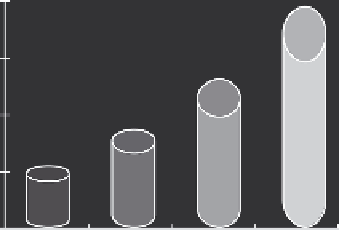Agriculture Reference
In-Depth Information
40
30
20
10
0
A
B
C
D
FIGURE 18.4
Comparison of China's cropland SOM level with those of the United States
and EU. (A) SOM level under 10 g/kg for the majority of croplands of China. (Data from
the Ministry of Agriculture and State Commission of Development and Reform, China.
A
National Planning of Conservation Tillage Project
. [AO/BO]. Available at
www.gov.cn/
gzdt/2009-08/28/content140367.html
,
2004.) (B) SOM level under 15 g/kg for all crop-
lands from the major agricultural production areas of China. (Data from the Ministry of
Agriculture and State Commission of Development and Reform, China.
A National Planning
of Conservation Tillage Project
. [AO/BO]. Available at
www.gov.cn/gzdt/2009-08/28/
content140367.html
,
2004.) (C) Mean level of SOM from the United States and EU countries.
(D) Critical SOM level for the United Kingdom. (From Pan, G.,
Adv Clim Change Res
5,
11-18, 20 09.)
the mean topsoil SOC content in croplands from the United States and EU countries
has generally been reported to be between 2% and 3%. In addition, Loveland and
Webb (2003) suggested a critical SOM level of 3.5% for temperate zone agriculture.
Thus, in comparison with soils of the United States and the EU, soils of China are
severely depleted of their SOC stock (Figure 18.4).
The low SOC stock in soils of China is also attributed to the increasing depen-
dence on chemicals and decreasing sustainability of China's crop production since
the end of the last century (Pan and Zhao 2005). The small per capita cropland area,
approaching the Food and Agriculture Organization's (FAO's) (2001) critical limit of
0.05 ha, and the low topsoil SOC content, which is lower than the world average by
30% (Huang and Sun 2006), are among the major constraints to China's agricultural
sustainability. It is this fact that urged the creation of a national climate change pol-
icy in agriculture to promote SOC enhancement through increasing input of biomass
C and protecting soils against degradation caused by intensified agricultural use of
croplands. This policy has been addressed in a national panel meeting of Xiangshan
Science Conference No. 362 (Pan 2009).
18.2.2 h
iStorical
c
hangeS
in
S
oil
c
arBon
S
tockS
of
c
hina
'
S
c
roplandS
It is widely accepted that the historic land use reduced the global SOC stock by 5%
(Lal 1999), with total loss of SOC stocks due to land use change estimated to be 55 Pg
by agricultural land use (Intergovernmental Panel on Climate Change 1996). However,
there exists much uncertainty in the estimates of historical loss of SOC stocks in China's

Search WWH ::

Custom Search